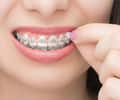Pain From Braces
The pain you may experience after a maintenance visit is common. That’s because adjustments made during these visits, like tightening wires and changing the colored rubber ligatures, put pressure on your teeth and the ligaments in your mouth. This process can cause pain and sensitivity. But like the first visit when you had your braces put on, the pain should fade away.
That being said, you may experience pain unrelated to your maintenance visit. The American Association of Orthodontists also lists discomfort due to your teeth moving, irritation caused by wires and brackets, and mouth sores as types of pain that might occur in-between orthodontist visits. Luckily, there are quick mends for all of these types of pain. But if you or your child experiences pain for more than a few days, reach out to your orthodontist.
Why Choose Orthodontic Treatment?
Don’t let the prospect of soreness or pain deter you or your child from getting braces. Not only do braces benefit your smile and confidence tremendously—but they can also help you avoid several oral health issues. If you don’t correct your bite, you could be putting yourself at risk for:
- Tooth decay or loss
- Gum disease
- Affected speech and/or chewing
- Abnormal wear to your tooth enamel
- Jaw problems
That’s why an early check-up is a must for your child. According to the American Association of Orthodontists, children should start getting orthodontic checkups as early as age seven to ensure that the adult teeth are coming in correctly.
The Application Process
The application process of braces is relatively painless, according to the American Association of Orthodontists. First, a retractor is put on the mouth to keep it open and dry. Your orthodontist will then etch your teeth with a mild solution, apply adhesive, and add a bracket to the top of the adhesive. From there, your orthodontist will remove any excess adhesive and dry it, and then thread the wire through the brackets. The wire will either stay in place using rubber bands or ligatures unless the brackets are self-ligating and clip the wire in place.
After your orthodontist has placed the wire, it's common to feel some pain, as the teeth are under pressure to move gradually. You may also find it difficult to eat or talk for a few days. This pain usually only occurs after your application appointment and after the routine maintenance visits for tightening and cleaning.
How to Relieve Braces Pain
Dealing with pain from braces is no fun—but fortunately, it’s easily treatable. For the most part, you can treat discomfort or soreness from your teeth moving with over-the-counter pain relievers like acetaminophen and ibuprofen. Rinsing your mouth with salt water can also help. If you’re experiencing irritation due to the wires or brackets, try applying dental wax to create a barrier between the metal and your mouth. And if mouth sores are your primary source of pain, you can use a topical anesthetic with a cotton swab.
After your first appointment and during any other painful episodes, eating soft, cold foods can help prevent extra discomfort due to chewing pain. Soft foods that don’t require much chewing, like soup, pudding, applesauce, mashed potatoes, and ice cream, are great options. You can also place an ice pack or cold cloth on your cheeks for a few minutes, just like you would for an injury or headache.
While most pain should lessen after a few days, talk to your orthodontist if your pain is ongoing, severe, or abnormal. They’ll equip you with the best treatment plan and see if you need any adjustments.
Taking Care of Braces
Now that you know how to deal with braces pain, it’s important to keep up on your oral hygiene because good oral hygiene is critical for healthy teeth and soft tissues during orthodontic treatment—brush at least twice per day, or better yet, after every meal. If small particles of plaque or food debris are left behind, it can leave you with white spots or decalcifications where the brackets were. Floss daily and rinse with mouthwash for protection against germs after drinking and eating.
Getting braces can be uncomfortable, but the outcome will be worth it. Not only will a straight smile add to your self-confidence, but your properly-aligned teeth will also allow you to chew and bite effectively. The result will be a beautiful, healthy smile that will last a lifetime!
Oral Care Center articles are reviewed by an oral health medical professional. This information is for educational purposes only. This content is not intended to be a substitute for professional medical advice, diagnosis or treatment. Always seek the advice of your dentist, physician or other qualified healthcare provider.
ORAL HEALTH QUIZ
What's behind your smile?
Take our Oral Health assessment to get the most from your oral care routine
ORAL HEALTH QUIZ
What's behind your smile?
Take our Oral Health assessment to get the most from your oral care routine
Join Us
Get the best of your oral health routine and take it to the next level with expert advice, recommendations, products and solutions and special offers.
Join Us
Get the best of your oral health routine and take it to the next level with expert advice, recommendations, products and solutions and special offers.















